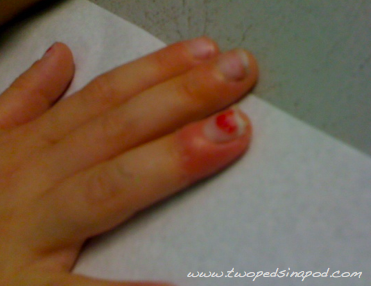Learn the signs: how to teach your baby sign language
Before babies gain the ability to say, “Mama, please hand me my cup from that table,” they will point at their cup. In other words, babies naturally use their own sign language to communcate. Today, teacher Kacey Slack writes about teaching American Sign Language as a way to help your child communicate before she masters spoken language.
–Drs. Lai and Kardos
Have you ever noticed your baby using hand gestures to express her needs? Most babies will raise their arms when they want to be held, wave goodbye, and point to what they need or want. What if your baby could tell you what she wanted before she learns to speak? Teaching babies to sign is simple and beneficial. According to child developmental psychologists Drs. Linda Acredelo and Susan Goodwyn, in Gaining a window into your baby’s mind, “Using signs with babies reduces tears, tantrums, and frustration, allows babies to express needs and share their worlds, enriches interactions between adults and babies and strengthens the parent-child bond, reveals how smart babies are, and increases parents’ respect for them and helps build babies’ self-confidence and self-esteem.”
Teaching signs is easy. You can use this link to learn basic signs. First demonstrate the sign while saying the word. You can also guide your baby’s hands if she will allow you. Praise any approximation of the sign. It will take some time before your baby will understand the sign and perform it. Be consistent and repeat the signs as often as possible. The more your baby sees the sign, the better she will understand it and be able to do it herself.
When beginning, choose a few signs that are useful to your baby such as “eat,” “more,” and “all done.” These are signs that babies encounter numerous times each day. Once your baby begins to sign, the possibilities are endless. She may want to learn zoo animals or you may want to teach her safety words in order to express if something is hot or cold or if she is hurt. Signing can also be used while reading books with your child. It is a great way to engage her and allow her to interact with literature.
You do not need expensive products or costly classes in order to teach sign. Play groups, however, offer parents the opportunity to receive guidance from an instructor, preferably one with experience signing as well as interacting with young children. Play classes also allow your child to interact with other children and learn from babies who may already know how to sign.
Helpful Links: the first link shows how to sign many common words.
http://www.aslpro.com/cgi-bin/aslpro/aslpro.cgi
https://www.babysigns.com/index.cfm?id=120
http://www.babies-and-sign-language.com/index.html
Kacey Slack
Independent Certified Instructor
Kacey Slack holds teaching certifications in elementary and special education. She has taught in various classroom settings and is an adjunct professor at Manor College. A mom of a young signing toddler, Ms. Slack is part of the Baby Signs® Program which helps guide other parents through their signing journey. She can be reached through www.babysignsprogram.com/bykacey.
© 2012 Two Peds in a Pod®
 The cut of mental illness can be
The cut of mental illness can be  At this time of the Jewish High Holy Days, Dr. Kardos offers us a glimpse into lessons learned as a doctor in training. This is a true story she wrote years after meeting Beth and until now, had only shared with a few close friends.
At this time of the Jewish High Holy Days, Dr. Kardos offers us a glimpse into lessons learned as a doctor in training. This is a true story she wrote years after meeting Beth and until now, had only shared with a few close friends. Wondering about preschool and toddler discipline? sleep? potty training ? emotional well being?
Wondering about preschool and toddler discipline? sleep? potty training ? emotional well being?  Often parents ask us how to encourage learning in their toddlers. Everyday experiences with parents and toys are more valuable than flashcards or television. To help understand how simple toys enrich toddler development, we bring you an excerpt from occupational therapist Barbara A. Smith’s award winning book From Rattles to Writing, A parent’s guide to Hand skills. We appreciated how the book gives tips on making your own toys, and lists very specific “to dos” to encourage not only fine motor development, but visual motor and sensory processing skills at different ages.
Often parents ask us how to encourage learning in their toddlers. Everyday experiences with parents and toys are more valuable than flashcards or television. To help understand how simple toys enrich toddler development, we bring you an excerpt from occupational therapist Barbara A. Smith’s award winning book From Rattles to Writing, A parent’s guide to Hand skills. We appreciated how the book gives tips on making your own toys, and lists very specific “to dos” to encourage not only fine motor development, but visual motor and sensory processing skills at different ages. 
 In the office it’s raining school forms. At this time of year, I see many of my patients embarking on their next stage of schooling. Kids I remember starting kindergarten are off to high school. Babies are starting daycare and teens are starting college. For all the parents who have a child entering a new school, whether it’s preschool or college, this letter is for you:
In the office it’s raining school forms. At this time of year, I see many of my patients embarking on their next stage of schooling. Kids I remember starting kindergarten are off to high school. Babies are starting daycare and teens are starting college. For all the parents who have a child entering a new school, whether it’s preschool or college, this letter is for you: Although it’s called ringworm, this rash isn’t caused by a worm. In fact, it barely looks like a worm. Otherwise known as tinea corporis, the patch of ringworm is usually a flesh or light-pink colored, slightly scaly oval with raised, red edges.
Although it’s called ringworm, this rash isn’t caused by a worm. In fact, it barely looks like a worm. Otherwise known as tinea corporis, the patch of ringworm is usually a flesh or light-pink colored, slightly scaly oval with raised, red edges. 